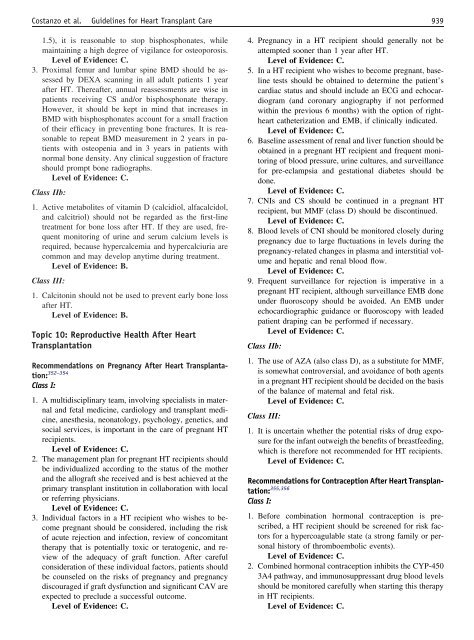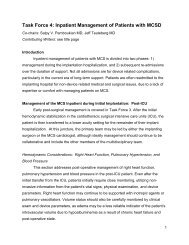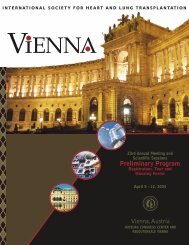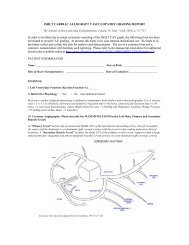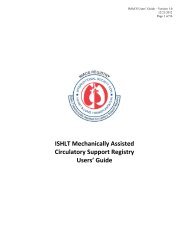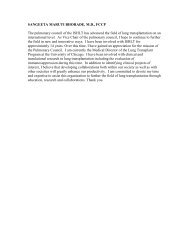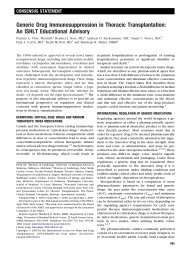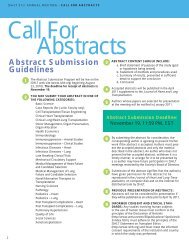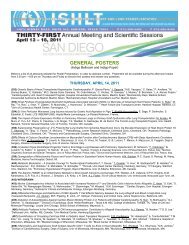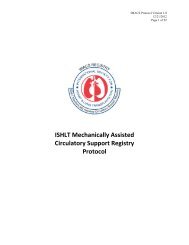Guidelines for the care of heart transplant recipients
Guidelines for the care of heart transplant recipients
Guidelines for the care of heart transplant recipients
Create successful ePaper yourself
Turn your PDF publications into a flip-book with our unique Google optimized e-Paper software.
Costanzo et al.<br />
<strong>Guidelines</strong> <strong>for</strong> Heart Transplant Care<br />
939<br />
1.5), it is reasonable to stop bisphosphonates, while<br />
maintaining a high degree <strong>of</strong> vigilance <strong>for</strong> osteoporosis.<br />
Level <strong>of</strong> Evidence: C.<br />
3. Proximal femur and lumbar spine BMD should be assessed<br />
by DEXA scanning in all adult patients 1 year<br />
after HT. Thereafter, annual reassessments are wise in<br />
patients receiving CS and/or bisphosphonate <strong>the</strong>rapy.<br />
However, it should be kept in mind that increases in<br />
BMD with bisphosphonates account <strong>for</strong> a small fraction<br />
<strong>of</strong> <strong>the</strong>ir efficacy in preventing bone fractures. It is reasonable<br />
to repeat BMD measurement in 2 years in patients<br />
with osteopenia and in 3 years in patients with<br />
normal bone density. Any clinical suggestion <strong>of</strong> fracture<br />
should prompt bone radiographs.<br />
Level <strong>of</strong> Evidence: C.<br />
Class IIb:<br />
1. Active metabolites <strong>of</strong> vitamin D (calcidiol, alfacalcidol,<br />
and calcitriol) should not be regarded as <strong>the</strong> first-line<br />
treatment <strong>for</strong> bone loss after HT. If <strong>the</strong>y are used, frequent<br />
monitoring <strong>of</strong> urine and serum calcium levels is<br />
required, because hypercalcemia and hypercalciuria are<br />
common and may develop anytime during treatment.<br />
Level <strong>of</strong> Evidence: B.<br />
Class III:<br />
1. Calcitonin should not be used to prevent early bone loss<br />
after HT.<br />
Level <strong>of</strong> Evidence: B.<br />
Topic 10: Reproductive Health After Heart<br />
Transplantation<br />
Recommendations on Pregnancy After Heart Transplantation:<br />
352–354<br />
Class I:<br />
1. A multidisciplinary team, involving specialists in maternal<br />
and fetal medicine, cardiology and <strong>transplant</strong> medicine,<br />
anes<strong>the</strong>sia, neonatology, psychology, genetics, and<br />
social services, is important in <strong>the</strong> <strong>care</strong> <strong>of</strong> pregnant HT<br />
<strong>recipients</strong>.<br />
Level <strong>of</strong> Evidence: C.<br />
2. The management plan <strong>for</strong> pregnant HT <strong>recipients</strong> should<br />
be individualized according to <strong>the</strong> status <strong>of</strong> <strong>the</strong> mo<strong>the</strong>r<br />
and <strong>the</strong> allograft she received and is best achieved at <strong>the</strong><br />
primary <strong>transplant</strong> institution in collaboration with local<br />
or referring physicians.<br />
Level <strong>of</strong> Evidence: C.<br />
3. Individual factors in a HT recipient who wishes to become<br />
pregnant should be considered, including <strong>the</strong> risk<br />
<strong>of</strong> acute rejection and infection, review <strong>of</strong> concomitant<br />
<strong>the</strong>rapy that is potentially toxic or teratogenic, and review<br />
<strong>of</strong> <strong>the</strong> adequacy <strong>of</strong> graft function. After <strong>care</strong>ful<br />
consideration <strong>of</strong> <strong>the</strong>se individual factors, patients should<br />
be counseled on <strong>the</strong> risks <strong>of</strong> pregnancy and pregnancy<br />
discouraged if graft dysfunction and significant CAV are<br />
expected to preclude a successful outcome.<br />
Level <strong>of</strong> Evidence: C.<br />
4. Pregnancy in a HT recipient should generally not be<br />
attempted sooner than 1 year after HT.<br />
Level <strong>of</strong> Evidence: C.<br />
5. In a HT recipient who wishes to become pregnant, baseline<br />
tests should be obtained to determine <strong>the</strong> patient’s<br />
cardiac status and should include an ECG and echocardiogram<br />
(and coronary angiography if not per<strong>for</strong>med<br />
within <strong>the</strong> previous 6 months) with <strong>the</strong> option <strong>of</strong> righ<strong>the</strong>art<br />
ca<strong>the</strong>terization and EMB, if clinically indicated.<br />
Level <strong>of</strong> Evidence: C.<br />
6. Baseline assessment <strong>of</strong> renal and liver function should be<br />
obtained in a pregnant HT recipient and frequent monitoring<br />
<strong>of</strong> blood pressure, urine cultures, and surveillance<br />
<strong>for</strong> pre-eclampsia and gestational diabetes should be<br />
done.<br />
Level <strong>of</strong> Evidence: C.<br />
7. CNIs and CS should be continued in a pregnant HT<br />
recipient, but MMF (class D) should be discontinued.<br />
Level <strong>of</strong> Evidence: C.<br />
8. Blood levels <strong>of</strong> CNI should be monitored closely during<br />
pregnancy due to large fluctuations in levels during <strong>the</strong><br />
pregnancy-related changes in plasma and interstitial volume<br />
and hepatic and renal blood flow.<br />
Level <strong>of</strong> Evidence: C.<br />
9. Frequent surveillance <strong>for</strong> rejection is imperative in a<br />
pregnant HT recipient, although surveillance EMB done<br />
under fluoroscopy should be avoided. An EMB under<br />
echocardiographic guidance or fluoroscopy with leaded<br />
patient draping can be per<strong>for</strong>med if necessary.<br />
Level <strong>of</strong> Evidence: C.<br />
Class IIb:<br />
1. The use <strong>of</strong> AZA (also class D), as a substitute <strong>for</strong> MMF,<br />
is somewhat controversial, and avoidance <strong>of</strong> both agents<br />
in a pregnant HT recipient should be decided on <strong>the</strong> basis<br />
<strong>of</strong> <strong>the</strong> balance <strong>of</strong> maternal and fetal risk.<br />
Level <strong>of</strong> Evidence: C.<br />
Class III:<br />
1. It is uncertain whe<strong>the</strong>r <strong>the</strong> potential risks <strong>of</strong> drug exposure<br />
<strong>for</strong> <strong>the</strong> infant outweigh <strong>the</strong> benefits <strong>of</strong> breastfeeding,<br />
which is <strong>the</strong>re<strong>for</strong>e not recommended <strong>for</strong> HT <strong>recipients</strong>.<br />
Level <strong>of</strong> Evidence: C.<br />
Recommendations <strong>for</strong> Contraception After Heart Transplantation:<br />
355,356<br />
Class I:<br />
1. Be<strong>for</strong>e combination hormonal contraception is prescribed,<br />
a HT recipient should be screened <strong>for</strong> risk factors<br />
<strong>for</strong> a hypercoagulable state (a strong family or personal<br />
history <strong>of</strong> thromboembolic events).<br />
Level <strong>of</strong> Evidence: C.<br />
2. Combined hormonal contraception inhibits <strong>the</strong> CYP-450<br />
3A4 pathway, and immunosuppressant drug blood levels<br />
should be monitored <strong>care</strong>fully when starting this <strong>the</strong>rapy<br />
in HT <strong>recipients</strong>.<br />
Level <strong>of</strong> Evidence: C.


